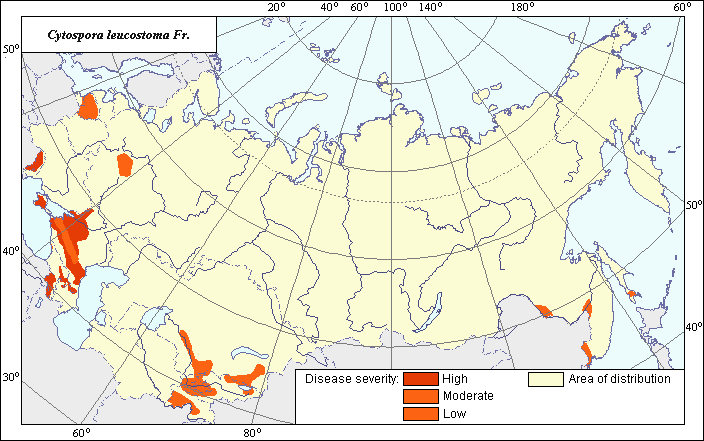Diseases
Distribution and severity zones of Cytospora leucostoma Fr.
 Object description Download GIS-layers
Object description Download GIS-layers
Authors:
Specialist-biologist - I.V. Bilder,GIS-specialist - M.I. Saulich.
Date of creation:
20.03.2005Scale:
1:20 000 000.Accuracy of map:
Map was created based on materials of map of natural scale 1: 33 000 000.Projection:
"Alber's Equal Area Conic for the USSR", 9, 1001, 7, 100, 0, 44, 68, 0, 0Basic contents:
Vector map. Area of species distribution and zones of disease severity are shown by polygons.Accuracy of classifier:
Distribution was determined based on the regions where the Cytospora Twig Die Back is registered on fruit crops according to published scientific materials. Within the limits of the disease area three zones of severity were distinquished. The disease occurs at least 1 time over a period of 2 years or almost annually in the zone of high severity; 1 time over a period of 3 years in the zone of moderate severity, and 1 time over a period of 5 years in the zone of low severity.Method of map production:
Scientists were given maps with boundaries of Oblasts and arable lands. After reviewing historic literature, species distribution was hand drawn on maps. If data were on the Oblast-level, distribution is on the Oblast level. In some cases, Oblast.s are further refined by boundaries of the Arable Land Map (Koroljeva et al., 2003). Hand drawn maps were scanned, georeferenced and vectorized. Distribution of the disease was presented on a map within the limits of fruit-growing in the countries of the former USSR, i.e., in Turkmenistan, Kara-Kalpakstan, Novosibirsk Region, Latvia, the Leningrad, Orel, Tambov, Kursk, Voronezh Regions. High severity of the Cytospora Twig Die Back of pear is observed in areas of intensive fruit growing of the North Caucasus (in the northern part of the Krasnodar and Stavropol Territories, in the Rostov Region, the Black Sea region, Kabardino-Balkaria, Chechnya, Ingushetia, Alania), in the most humid areas of Transcaucasia, in Moldova, Ukraine (Crimea), East Georgia, Armenia. Moderate severity of the disease is observed in the southern part of the Krasnodar and Stavropol Territories, in Adygea, Karachay-Cherkessia, Lithuania, Kazakhstan, and republics of Central Asia. Low severity of the disease is observed in areas of fruit growing in the Far East, in the Moscow Region. The following sources were used to determine the areas for this map: Tsakadze (1956), Gerbanevskaya (1958), Kropis (1958), Byzova et al. (1968), Dobrovolskene (1969), Minkevich et al. (1971), Konstantinov & Shkreba (1972), Petrushova et al. (1975), Isin (1981), Bazerashvili (1985), Ostasheva (1987), Smolyakova (2000).Reference citations:
Bazerashvili L.G. 1985. Complexes of fungi concomitant to drying of peach and apricot, and ecological substantiation of control measures. Tbilisi: Goskomizdat Gruz. SSR. 24 p. (In Russian)Byzova, Z.M., Vasyagina, M.P., Deeva, N.G., Kalymbetov, B.K., Pisareva, N.F., & S.R. Shvartsman. 1967. Flora of spore plants of Kazakhstan. V. 5, part 1. Sphaeropsidales. Alma-Ata: Nauka. 339 p. (In Russian)
Dobrovolskene A. 1969. Biological researches of drying (agent Cytospora capitata Sacc. et Schulz.) of fruiters in Lithuanian SSR. In: Midvikiene D., ed. Intensification of agriculture production. Proceedings. Vilnus: Mintis. V. 16, Issue 2(41): 48. (In Russian)
Gerbanevskaya E.V. 1958. Nature drying of stone fruit crops. In: Solobyeva A.I., ed. Collection of scientific phytopathologic works of VIZR Central Asian branch. Tashkent: VIZR. 23-30 p. (In Russian)
Isin M.M. 1981. Specialization of some Cytospora species on fruit-berry species, trees and shrubs. In: Emelyanov V., ed. Plant protection against pests and diseases. Elgava: Lithuanian Agricultural Academy. 76-78 p. (In Russian)
Khokhraykov M.N., Dobrozrakova T.L., Stepanov K.M., Letova M.F. 1966. Keys to plant diseases. Leningrad: Kolos. 592 p. (In Russian)
Konstantinov L.K., Shkreba V.S. 1972. Drying of fruit trees. Zashchita rastenii, 8: 60. (In Russian)
Koroljeva IE, Vilchevskaya EV, Ruhovich DI. 2003. Digital Arable Land Map. Laboratory of Soil Information of the Dokuchaev Soil Institute, Moscow, Russia [Based on: Yanvareva LF. (ed.), Martynjuk KN., Kisileva NM. 1989. Map of Land Use, Faculty of Geography, Moscow State University, Moscow, Russia.].
Kropis E.P. 1958. Infectious drying of stone fruit trees and their control. Kishinev: Moldavian station of VIZR. 11 p. (In Russian)
Minkevich I.I., Barsukova O.N., Kulibaba Yu.F., Cherepkova N.A. 1971. About parasitism of fungi of genus Cytospora on stone fruit crops. In: Tsitsin N.V., ed. Bulletin of the main botanic garden. V. 80. Moscow: Nauka. 89-93 p. (In Russian)
Ostasheva N.A. 1987. Cytospora of fruit trees. Zashchita rastenii, 9: 34. (In Russian)
Petrushova N.I., Ovcharenko G.V., Evmenenko A.F., Medvedeva G.V. 1975. Role of fungi of genus Cytospora Fr. in drying of stone fruit crops in Crimea. Mikologiya i fitopatologiya, 9(4): 315-319. (In Russian)
Smolyakova V.M. 2000. Fungal diseases of fruit trees in South Russia. Krasnodar: Vest.. 192 p. (In Russian)
Tsakadze T. 1956. On study of parasitism of Cytospora leucostoma (Pers.) Sacc. on stone fruit cultures. In: Berishvili I., ed. Works of Plant Protection Institute. V. 2. Tbilisi: Academy of Sciences of Georgian SSR. 209-219 p. (In Russian)

